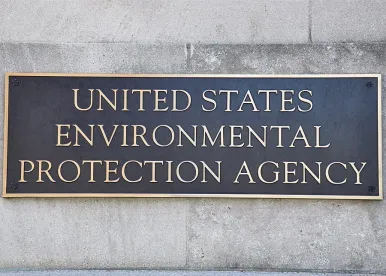Responding to July 2017 and March 2018 orders issued by the U.S. Court of Appeals for the District of Columbia Circuit, the U.S. Environmental Protection Agency (EPA) on May 30, 2018, issued a final rule revising the Definition of Solid Waste (DSW) under the Resource Conservation and Recovery Act (RCRA). 83 Fed. Reg. 24664. In a somewhat unusual move, EPA relied upon Section 553 of the Administrative Procedure Act (APA) to make the rule immediately effective and dispensed with notice and public comment. Under APA Section 553, EPA is authorized to forego notice and comment rulemaking when “for good cause” EPA finds that these procedures are “impracticable, unnecessary or contrary to the public interest.” EPA determined that there is good cause for revising these provisions “because these revisions simply undertake the ministerial task of implementing court orders vacating these rules and reinstating the prior versions.”
On July 7, 2017, the D.C. Circuit found “unreasonable,” and thus threw out, the “verified recycler” exclusion promulgated by EPA in its 2015 revisions to the DSW. The court reinstated the “transfer-based” exclusion promulgated by EPA under the Bush Administration. In the case, American Petroleum Institute v. EPA (D.C. Cir. No. 09-1038), the court also removed one of the provisions of the legitimacy criteria. The court upheld all other portions of the 2015 rule and rejected the environmental groups’ challenges to it. The court then amended its ruling on March 6, 2018. In that ruling, the court tweaked its 2017 decision in three ways. First, the court held that spent petroleum catalysts do qualify for the transfer-based exclusion. Second, the court vacated in its entirety Factor 4 of EPA’s legitimacy criteria. That factor required that, to be considered legitimate recycling, the product of the hazardous waste recycling process must be comparable to a legitimate product or intermediate. Third, as a result of vacating Factor 4, the court also held that the 2015 change to the DSW making the legitimacy factors applicable to all exclusions remains, that Factor 3 remains mandatory, and that the 2008 version of Factor 4 replaces the now-vacated 2015 version. In response to this brace of decisions, EPA’s May 30, 2018, final rule does the following:
-
Removes the 2017 verified recycler exclusion and reinstates the 2008 transfer-based exclusion. In the 2015 rule, EPA replaced the 2008 rule transfer-based exclusion found at 40 C.F.R. Section 261.4(a)(24)–(25) with the verified recycler exclusion, found at 40 C.F.R. Section 261.4(a)(24) (the goal of both exclusions was to exempt from regulation off-site recycling of hazardous waste when certain conditions are met). In promulgating the 2015 verified recycler exclusion, EPA made four key changes to the language of the 2008 transfer-based exclusion: (1) removed a prohibition that had made certain spent petroleum catalysts (hazardous waste codes K171 and K172) ineligible for the new recycling exclusions (i.e., these materials became eligible under the 2015 exclusion); (2) added a specific ‘‘contained’’ standard for the management of the materials prior to being recycled; (3) added emergency preparedness and response requirements; and (4) replaced a requirement for generators to make a ‘‘reasonable effort’’ to audit the recycling facility prior to sending their material to be recycled with a requirement that the recycling facility obtain a variance from the regulations prior to accepting the recyclable materials. In its decisions vacating the 2015 verified recycler exclusion and ordering the reinstatement of the 2008 transfer-based exclusion, the court found that the first three provisions noted above were severable from the rest of the verified recycler exclusion and would not be affected by the vacatur. These provisions are retained in the reinstated transfer-based exclusion found in the revised version of 40 C.F.R. Section 261.4(a)(24). In addition, EPA reinstated the export requirements for the transfer-based exclusion found and made several conforming changes in response to the vacatur of the verified recycler exclusion and reinstatement of the transfer-based exclusion.
-
Removes the 2015 Factor 4 in the Definition of Legitimate Recycling and Reinstates the 2008 Factor 4.In the 2015 DSW rule, EPA revised the definition of legitimate recycling found at 40 C.F.R. Section 260.43, which was originally promulgated in the 2008 rule. In both the 2008 and 2015 versions of the regulation, the legitimacy provision was designed to distinguish between legitimate and sham recycling. This provision represented the codification of a long-standing policy prohibiting sham recycling that had previously been applied via Federal Register preamble and guidance documents. Factor 4 required that the product of the recycling process be comparable to a legitimate product or intermediate in terms of hazardous constituents or characteristics. EPA has now revised this provision to be considered and not mandatory.
Implications
Implementation of the revised rules is a hodgepodge. The immediate effect of the May 30 final rule depends upon the authorization status of each state. For the two states that have no final RCRA authorization -- Alaska and Iowa -- the revised rules are effective immediately. States that have final authorization but that did not adopt the 2015 verified recycler exclusion are not required to adopt or become authorized for the reinstated transfer-based exclusion, as it is less stringent than full hazardous waste regulation. States that have RCRA authorization but have not adopted the 2015 definition of legitimate recycling are, however, required to adopt and become authorized for that definition. For states that have adopted rules similar to the verified recycler exclusion and the 2015 definition of legitimate recycling, but have not yet been authorized for them, the May 30 final rule will not change the authorization status of the state programs. For states that have previously been authorized for rules similar to the verified recycler exclusion and the 2015 definition of legitimate recycling, and have been authorized for them, the effect of the May 30 rule is that those previously-authorized state provisions will be considered broader in scope than the federal program (and thus non-enforceable by EPA).


 />i
/>i

